uploaded
by Kenji Siratori to Academia.edu on December 27, 2024, 6:03am (1 day ago). 
Gary J. Shipley’s VOID DEER OR FOXHOLE WITH EXTENDED TEETH inhabits a liminal space where human perception disintegrates and fuses with external systems. The narrator’s room—a microcosm of decay and revelation—becomes an experimental site for observing the entropic dance of life and death. As Shipley writes, “The room was too small, so mum said she wanted to go. Mum knew things. Mum was God.” This collapsing of familial, divine, and ecological systems mirrors the feedback loops that define biological systems. A core principle of systems biology is the feedback loop, wherein outputs of a system recursively influence its inputs. Shipley’s text constructs a narrative feedback loop in which perception, environment, and biological decay interact symbiotically. The narrator’s rash, expanding across their body, exemplifies a system destabilizing under entropic forces: “The rash on my leg is bigger now. Grown since yesterday.” The rash’s progression is not merely a symptom but a site where biological entropy and psychological instability feed into one another. This entropic feedback loop aligns with Shipley’s vision of a porous existence: “Living in a porous room is its own relief.” The room, both container and participant in decay, becomes a node in a larger ecological system—a “reverse rectum of a planet” processing its own waste. Systems biology’s focus on boundary permeability finds resonance here, as Shipley dismantles the distinction between inside and outside, self and other. In systems biology, emergent properties arise from the interaction of system components, creating phenomena irreducible to individual parts.
Shipley’s narrative generates such emergence through “mush,” a recurring motif that resists interpretation while demanding attention. “Turning to mush is its secret language. I learn to speak it without speaking to anyone.” The mush represents the narrator’s interface with the ineffable, a biomimetic process where structure dissolves into formlessness, only to give rise to new configurations. This is reminiscent of biological systems reorganizing under stress, where molecular or cellular disarray leads to novel states of order. The mush becomes an ontological substrate, its insistence on “certain words” paralleling the genetic code’s role in biological systems. As Shipley’s narrator observes, “The mush insists certain words be found. Certain arrangements.” The text itself behaves like a genome, encoding emergent meanings in its “pictures of the world digesting in the other throat of God.” The narrator’s room, overwhelmed by decay and suffocation, exemplifies metastability—a system balanced precariously between order and collapse. The “suction” pulling birds and dogs into the room underscores this delicate equilibrium: “I control the rate of suction. They beg me to turn it off…” Yet the narrator’s refusal to intervene reflects a systemic inevitability, echoing the way biological systems tolerate stress up to a tipping point before catastrophic failure. In this metastable state, the narrator becomes both observer and participant in a collapsing ecosystem: “When I outgrow this room it will be because it contains everything that was once outside it.” The room’s implosion—its reduction to a singularity of existence—redefines spatial and ontological boundaries. Systems biology offers insight into this collapse, framing it as a natural consequence of overburdened networks. A key element of systems biology is the role of information processing in sustaining life. Shipley’s narrator exists in a computational haze.
Where neurochemical instability and digital networks converge: “A neurocomputational gateway is a noisy place to think.” The narrator’s fragmented cognition mirrors the stochastic behavior of neural networks, while their “screenshots of the world” evoke the algorithmic sorting of environmental data. The artificial voice used to communicate with friends further blurs the distinction between biological and artificial systems. This hybridized existence, where “I do not need to think for all the noises to work,” situates the narrator as a cyborg entity, embodying the interface between human and machine. Systems biology’s integration of computational models with biological processes provides a framework for understanding this cybernetic synthesis. Take, for instance, Shipley’s assertion: “Speaking becoming a kind of rotting.” This line evokes a decaying system, where language, as a living organism, succumbs to entropy. In biological terms, decay can be seen as a shift in systemic equilibrium, where the breakdown of one structure fosters the growth of another. Language, in Shipley’s hands, is not static but metabolic—it decomposes into fertile ground for visceral, emergent imagery: “My accidie is an old bobblehead with its face worn off waiting for an earthquake.” Here, the oscillation between inertia and potential violence reflects a metabolic stasis awaiting disruption.
Shipley’s notion of “diabolic possession” by “cameras, computers, phones, and TVs” resonates with the concept of feedback loops in systems biology. These devices, as nodes within a network, generate recursive interactions with their users, creating self-sustaining circuits of obsession and alienation. Similarly, biological feedback loops regulate homeostasis, often veering into pathological states when dysregulated. “Corpses pregnant with themselves,” Shipley writes, a haunting metaphor for autocatalysis—the biochemical phenomenon where products of a reaction catalyze their formation, perpetuating cycles of self-generation and degeneration. Shipley’s fragmented characters also serve as nodes within a larger, dysfunctional system. The cryptic “friends” who populate his prose, identified by numeric pseudonyms, simulate stochastic interactions within a chaotic network. “Friend>>326****7 says he is legally sane. Friend>>326****8 says she is not, and that she feeds her faeces to the babies in her care.” These figures, simultaneously grotesque and banal, introduce perturbations into the narrative’s equilibrium, much like external stimuli destabilize biological systems. The resulting disarray fosters emergent patterns—“a shrine” of “marbling” on the narrator’s screen—a synthesis of chaos and order. Central to Shipley’s poetics is the body’s materiality. The “rash on my leg”, progressively described as a “hole,” reflects the degradation of physical boundaries, an ontological erosion that parallels the permeability of biological membranes. The narrator’s lived experience becomes a site of somatic and semantic collapse.
Underscoring the fragility of self-containment within systems. In systems biology, phenomena like apoptosis (programmed cell death) ensure systemic health by eliminating dysfunctional components. Shipley subverts this principle; his systems accumulate waste and perpetuate sickness: “Sickness must be exploited in order to become well.” This aphorism critiques a cultural pathology that valorizes productivity through pain, reframing sickness as a systemic inevitability rather than an aberration. Shipley’s interplay of heat and cold, of bodies “with an appetite for the other’s warmth” or the “thick and peaceful and hard to breathe” air, conjures thermodynamic principles. His prose oscillates between entropy and negentropy, charting the narrator’s resistance to systemic dissolution. “All my friends waving fakes of their severed ears,” he writes, situating decay alongside grotesque mimicry, an uncanny vitality arising from the vestiges of destruction. Gary J. Shipley’s writing inhabits a liminal space where language dissects itself, becoming an organism of sorts—a living, mutating system. Shipley's fragmented, grotesque, and hyperrealist prose aligns with the principles of systems biology, which conceptualizes life as the interaction of dynamic, nonlinear processes. His depiction of human disarray—“The sum of my discontinuities is more than all the nothings on Margate sands”—echoes the core idea of emergent complexity: that the whole exceeds the sum of its parts. Shipley’s destabilized narrative is a biological “flophouse for the soul,” revealing the boundaries and failures of systems, whether they are corporeal, cognitive, or linguistic.
The recurrent motif of "sporulation" in Shipley’s text functions as both a biological and philosophical metaphor. Sporulation, a survival mechanism in bacterial life forms, represents a state of dormancy and resilience under hostile conditions. Shipley’s description—“Friend>>326****9 induced to sporulate”—transposes this microbial process onto human and digital domains. Here, the boundaries between biological life and technological existence blur, suggesting that survival in postmodernity involves the dissociation of identity into modular, dormant states. Systems biology explores such modularity, examining how living systems partition functions into smaller, semi-independent units. Shipley’s characters, fractured into numerical pseudonyms and ephemeral voices, mirror this partitioning: fragmented selves navigating inhospitable informational ecosystems. This sporulation is not merely survival but adaptation to a context where coherence—biological, linguistic, or emotional—becomes untenable. Exaptation, the biological concept of traits co-opted for new purposes, resonates with Shipley’s narrative paradoxes. His phrase, “My life is kind of paradoxes making promises. Paradoxes melting,” encapsulates this phenomenon. Traits, objects, and emotions in Shipley’s world are repurposed under duress: “Friend>>326****4 asks why the top of my leg is wrapped in cellophane. I say it’s to stop things falling in.” Here, mundane objects acquire grotesque, almost survivalist utility, underscoring the repurposing of structures under existential pressure. In systems biology, exaptation reveals how evolutionary pathways emerge from serendipitous redeployment rather than deliberate design.
Similarly, Shipley’s linguistic and thematic assemblages transform familiar materials into unexpected configurations, evoking an emergent order from seeming chaos. The grotesque humor in lines like “Scissoring off a face is just disgusting—but funny the way Friend>>326****3 does it” highlights this process of transformation, repurposing human disintegration into moments of dark levity. Shipley’s prose operates as an open system, absorbing and expelling information with chaotic intensity. The “clawing sensation behind my forehead” may be read as a somatic response to the cognitive overload characteristic of modern information systems. This parallels the concept of noise in systems biology, where random fluctuations can disrupt or recalibrate biological processes. In Shipley’s narrative, noise takes on a phenomenological dimension, as the sensory chaos of “heat migraines,” “garbage,” and “cola-rich piss” saturates the text, dissolving boundaries between the internal and external. Shipley’s self-aware commentary—“I whispered to the ear saying science doesn’t know us; we all conceal sensory information”—challenges the reductionism inherent in scientific and systemic approaches to human experience. His critique aligns with the limitations of systems biology, which often struggles to account for the phenomenological and subjective dimensions of life.
The Body as a System in Crisis: At the heart of Shipley’s writing is the body as both a biological system and a symbol of systemic breakdown. The references to "metabolic churning" and "abnormally awkward mutism" suggest a system in flux, where the body’s normal functions are disrupted by a profound disorder. This imagery resonates with the language of systems biology, where biological functions are understood in terms of complex feedback loops and regulatory mechanisms that can go awry under certain conditions. Shipley’s description of the body is not merely anatomical but also indicative of a broader collapse of order—"The ethical just a post-primate fashion statement"—which mirrors the disintegration of societal and biological norms. The "multichannel receptivity" speaks to the body’s struggle to process external stimuli, mirroring the overstimulation often seen in cases of neurological disorders. Here, Shipley seems to suggest that the body is not a closed system but rather an entity in constant exchange with the external environment—infected, bombarded, and disintegrating. This reflects the biological principle of homeostasis, the process by which living systems maintain internal balance despite external perturbations.
Shipley’s characters, however, are trapped in a state of imbalance, as the biological rhythms they should follow have become distorted. The Concept of Autonomy and Agency in Biological Systems: Another prominent theme in Shipley’s work is the tension between autonomy and control. "God creates suitable hands, autonomous for more artistic force" evokes the biological concept of autonomy in systems—where organisms can exhibit agency despite external constraints. This autonomy, however, is portrayed as both a liberating and destabilizing force.
Shipley’s characters navigate a world where their actions, even when seemingly autonomous, are intrinsically tied to a broader collapse of systems—social, personal, and biological. This reflects a key concept in systems biology: the idea that individual cells or organs may function independently, but they are always influenced by the larger system in which they exist. The "autonomous hands" Shipley describes can be understood as a metaphor for the biological systems that are capable of self-regulation but may fail under extreme conditions. In the context of the narrative, autonomy is not a sign of healthy function but of dysfunction, as the protagonist’s actions seem disconnected from a coherent sense of purpose or direction. The body’s "hallucinogen-fed brains" and "zombie feedback psychosis" highlight the collapse of cognitive control and the disruption of feedback loops that sustain normal mental function. Feedback Loops, Dissolution, and Rebirth: Shipley’s portrayal of systemic collapse reaches its apex in his references to "biological dissolution" and "rebirth".
This cyclical process mirrors concepts in systems biology related to cellular turnover and metabolic pathways. The idea that the body or system can dissolve and regenerate, however, is less an optimistic vision of renewal and more a bleak commentary on entropy and the inevitability of decay. The "glorious rebirth" is ironic in its emptiness; it does not signify true recovery but rather the endless process of destruction and re-formation that defines life at the cellular level. The "experience just this indiscriminate mirror" symbolizes the feedback loop of biological and psychological states, where actions and outcomes feed into one another, creating a cycle of perpetual decay. The metaphor of "200 disguised beings of type X" observed "doing while positive in Baltimore" evokes an image of collective action devoid of meaning or direction, suggesting that biological systems—when taken out of context or disrupted—become little more than empty forms, devoid of purpose. This recursive feedback loop points to the systems biology concept of positive and negative feedback: in a healthy system, negative feedback is the primary mechanism for maintaining homeostasis. In Shipley’s work, however, the feedback is overwhelmingly positive—disruptive and self-reinforcing—leading to the eventual dissolution of the organism as a functioning system.
The presence of "disguised beings" further hints at the way identity and function become distorted within a system that is falling apart. Existential Reflections on Death and the Biological System: Death is an ever-present theme in Shipley’s work. From the "fly lands on my face every day at the exact same time" to the chilling image of "everyone shot dead in LA today playing dead", Shipley portrays death not as an end but as an ongoing process. This reflects the biological reality that death is a constant, inevitable part of living systems, whether at the cellular level or within the context of ecological and evolutionary systems. In Shipley’s narrative, death is not something to be feared but something that is integrated into the fabric of life itself. The description of "a fly landing on my face" as a cyclical and repetitive event highlights the biological processes of entropy and decay. The fly’s movements are like the inevitable biological processes that continue regardless of individual human will or perception. Shipley’s exploration of death and decay could be seen as a critique of the assumption that life operates in linear progression—life, death, and rebirth are not neatly separated but form an ongoing loop of biological and existential dissolution.
In Gary J. Shipley’s fragmented narrative, the interplay between life and death, the inner and outer realms of experience, and the boundaries of consciousness are explored with a stark and unsettling surrealism. Shipley’s writing is an unsettling terrain where words dissolve and reconstitute themselves in a dance of bodily degradation and existential despair. By analyzing the human body as an emergent system that evolves within an environment characterized by biotic and abiotic interactions, Shipley’s exploration of the corporeal and the internal emerges as a commentary on the fragility of consciousness and the inherent disconnect between lived experience and biological mechanisms. Shipley’s text often oscillates between seemingly trivial dialogue and profound revelations of the self. The line “I listen to a conversation between two people. They are outside somewhere. I don’t see them. I don’t know who they are. It feels like the words are also for me. Like terrible things can also be mundane” highlights the pervading sense of disconnection between the individual and external reality. This disconnection can be interpreted as a failure in the body's feedback systems, where sensory input is processed in ways that do not align with the individual’s perception of reality. Systems biology, with its emphasis on feedback loops and the regulation of bodily processes, suggests that the body itself is not a static entity but a dynamic, interconnected system subject to constant modification through both internal and external forces. The passage reflects a lack of clarity about the self in relation to the environment. Shipley’s work creates a space where the boundary between the external world and internal states is porous, and the question of identity is both fragmented and dispersed. Systems biology posits that identity is emergent—consciousness arises from the interaction of various biological systems (the neural, the endocrine, the immune, and so on) that regulate the body’s interaction with the environment.
Shipley’s narrative calls attention to the fragility and instability of these systems, emphasizing the tension between what is biologically experienced and how it is cognitively processed. His characters’ inability to define themselves or distinguish between inner and outer forces can be seen as an expression of the disintegrating coherence between mind and body. The disintegration of perception in Shipley’s text can also be explored through the lens of neural networks and their role in shaping individual experience. The disembodied voice narrating “I’m not sure… it didn’t look like that to me. But I could tell what was going on” illustrates an inability to reconcile external stimuli with internal states. In systems biology, the brain functions as a complex, adaptive system that interprets and responds to sensory data.
However, when these sensory inputs fail to cohere—either due to psychological or physiological disruptions—the brain’s systems may produce disjointed or conflicting interpretations of reality. Shipley’s portrayal of a detached, often confused sense of self mirrors the neural misfiring that could occur in certain neurological conditions, where the brain fails to properly integrate sensory and cognitive information. For example, Shipley writes, “We had a house with a living room. We kept talking. More than we needed to.” This mundane recounting of an everyday scene—interrupted by moments of nihilistic confusion—mirrors how systems biology might approach memory and experience. The house, the living room, the act of talking: all these are part of the social and environmental stimuli that the brain processes. Yet, the individual’s inability to understand what is happening in the moment—“But I found out. In the end, I found out”—echoes the body's struggle with memory encoding, processing, and the biological mechanisms that underpin the experience of time.
This interplay between the interior and exterior is not confined to the mind; it extends throughout the body. The passage “I had a work-related accident that led to the amputation of my lower right leg” points to the relationship between trauma and bodily systems. Systems biology considers how injuries and biological trauma disrupt the homeostasis of bodily systems, affecting everything from immune responses to the psychological responses to pain and loss. The dismembered body in Shipley’s work symbolizes the breaking down of the self, where bodily experience and existential meaning collide. In this space, systems biology offers a perspective on how the body’s response to trauma, both physically and psychologically, emerges as a system trying to recalibrate in the face of overwhelming change. The motifs of consumption and decomposition in Shipley’s writing, such as the cannibalistic ritual “The cannibals all hang at the Mission eating each other,” underscore an existential reflection on the cyclical nature of violence, suffering, and survival. Systems biology focuses on the feedback loops in ecosystems, where organisms are both consumers and consumed. Shipley’s recurring theme of consumption reflects the biological imperatives that drive behavior—eating, digesting, and eventually decomposing. These systems are essential for life, but in Shipley’s text, they take on a macabre, distorted form where the act of consumption becomes not just physical, but existential. The act of consuming the self—symbolized by cannibalism—is a perverse form of homeostasis, where the body’s processes are turned inward, emphasizing the cyclical destruction of identity and purpose. In a biological context, cannibalism can be seen as an extreme form of resource allocation in desperate environments.
In Shipley’s world, this “resource” is not merely sustenance but the very essence of existence—the self devouring itself in a constant feedback loop of violence and renewal. Shipley writes, “The sun is not full of worms anymore. The clouds almost never shriek.” This shift in imagery—from one of organic decay to something more muted and distant—may suggest a loss of the vital feedback signals that sustain life. In biological systems, such losses can lead to disintegration, whether it’s the collapse of ecosystems or the breakdown of bodily processes. For Shipley’s characters, the loss of meaningful connection to the environment is mirrored in their biological decay, a reflection of the profound alienation that is both mental and physical. His portrayal of the body and mind as systems in crisis reflects the constant tension between survival and decay. The body, a network of biological feedback loops, is portrayed as both a vessel and a battleground—subject to external influences, internal conflicts, and, ultimately, its own unraveling.
Shipley’s exploration of trauma, disembodiment, and existential despair challenges the reader to reconsider the assumptions of stability and coherence that systems biology might otherwise offer. In this sense, his work serves as a powerful commentary on the complexity and fragility of human life, revealing the ways in which biological processes can both sustain and erode our understanding of the self. In Shipley’s universe, the body is never static—it is always in motion, caught between life and death, the mundane and the monstrous, a fragile system desperately seeking balance. Heterotransplantation, Language, and the Cyclical Nature of Biological and Cultural Systems: The integration of biological systems with human culture through language, technology, and ecology has sparked new avenues of philosophical and scientific inquiry. Drawing on concepts from systems biology, the notion of heterotransplantation—the transplantation of genetic material or organisms across species boundaries—emerges as a central theme for understanding the exploitation of planetary life.
The discussion integrates theoretical concepts on identity, translation, and cultural expression, ultimately considering how the processes of life and language interconnect in systems that transcend human authorship and embrace synthetic, alien forms of existence. In understanding how language and capital intersect with biological systems, it is crucial to consider the statement, "The understood space is now utilized by society for the exploitation of planetary life, or expressed through linguistic ethics." This suggests that society, having mastered the material and linguistic domains, now seeks to control and exploit life itself—an extension of the language of power. From the perspective of systems biology, this exploitation mirrors the ways in which organisms interact with their environment, with the "cycle of language" representing a feedback loop of cultural and biological exchange. The failure of JV in the market can be interpreted as a breakdown in this system, where the logic of capital fails to adapt to the evolving biological realities of life. The system of language, by extension, becomes increasingly inadequate to represent or support the rapidly mutating systems of life and identity. The shifting role of language in a biological context aligns with the "new critical root" of human expression, which resists human authorship and instead embraces "gestures of bacteria." Here, bacteria symbolize the simplest, most fundamental biological agents, capable of transcending human dysfunction and becoming a "fused logical system." This is a critique of traditional human-centered models of authorship and creation, suggesting that human systems of thought, bound by language and cultural conventions, fail to account for the complex interrelations inherent in biological ecosystems. Bacteria, in their simplicity and adaptability, become the symbol of biological systems that are not merely passive but actively engage in the creation of meaning in ways that humans are only beginning to understand.
The concept of capital expanding into a "divine human space" or "translation, identity, and logic of resistance" underscores the entanglement of biological, linguistic, and economic systems. In systems biology, the idea of capital mutating into a form of "divine" control can be understood as the reification of biological processes into a commodity. This shift echoes the way in which capital moves from being a human-centered system to something more abstract, aligning with the logic of biological systems themselves. In this model, the processes of life are transformed into economic units that reflect both material and conceptual value. The "fear and emotional text" produced by this system is a reflection of the underlying anxiety surrounding the commodification of life and the ethical implications of manipulating biological systems. These processes are compounded by the collective practices and "interface language" that emerge from interactions between humans, technology, and biology.
The "words of Akitu" and the reference to a "synthetic example" suggest the emergence of new cultural forms that blur the boundaries between the organic and the synthetic. Systems biology supports this idea by emphasizing the adaptability and resilience of biological systems, which are constantly reshaping their structures and relationships with the environment. Heterotransplantation, the biological equivalent of cultural appropriation, represents the ultimate subversion of human identity through the introduction of non-human elements into the genetic code. This process, when viewed through the lens of systems biology, highlights the potential for "infinite assimilated methods" that merge species and biological systems in ways that transcend traditional boundaries. The introduction of alien genes or biologically altered organisms challenges our existing notions of identity, with "DNA in global modules" rejecting the boundaries imposed by human cultural constructs. The "rupture of language" mentioned in the text can be understood as a metaphor for the breakdown of human-centric systems of meaning, replaced by the complex interactions between different biological entities.
The reference to "Babylonian gestures of escape" suggests a symbolic rejection of the static systems of language and culture, replacing them with dynamic, biologically driven forms of communication. This rupture reflects the ways in which genetic engineering and heterotransplantation are subverting traditional human constructs, forcing us to rethink the boundaries of life and identity. The discussion of "alien powers" and the "geopolitics of heterotransplantation" underscores the political dimensions of biological intervention.
In systems biology, the material forces that drive biological systems are often entangled with political and economic forces. The manipulation of biological life, whether through genetic modification or transplantation, becomes a form of power that is both technological and political. The "inherent human cytokines" and the "ethics of heterotransplantation" represent the ethical dilemmas faced by society as it moves toward greater control over biological processes. The transformation of biology into a site of political contestation reflects the growing tension between technological advancement and ethical responsibility. The final reference to "CRISPR" and the "destabilization of human functions" is a poignant reminder of the radical potential of modern genetic technologies. CRISPR, as a tool for editing genes, embodies the paradox of control and chaos in the biological realm. While it holds the promise of eliminating genetic diseases, it also raises profound questions about the ethics of creating new life forms and the potential consequences of tampering with the very fabric of existence.
“Heterogenesis serves not performatively but as a tool for philosophical consumption. Potential languages are written internally, by which this mirror invites the replication and production of language—mirrors beneath mirrors. They transcend emotions.” These words invite us to consider heterogenesis as more than biological differentiation; it is a lens for understanding the recursive and reflective nature of systems. The mirror metaphor underscores the idea that life’s processes are not merely expressions of pre-existing scripts but rather iterative productions of new realities. Systems biology, with its focus on networks and interconnections, resonates deeply with this view, emphasizing the emergent properties that arise from recursive interactions. Philosophers attempting to clone the “linguistic context” of existence often confront the challenge of articulating these recursive dynamics. The “unspoken language” referenced here aligns with the idea that biological systems, like linguistic systems, operate beyond human semiotics, in the realm of molecular codes, feedback loops, and dynamic equilibria. “Monstrous consistency symbolizes heterotransplantation—a sign of terror, a byproduct of meaningful, idealized existential artistry.” This description captures the tension between biological innovation and the cultural frameworks that seek to assimilate it. Systems biology investigates phenomena such as CRISPR-Cas9, a “crisis expression of cuteness,” where the precision of genetic editing tools highlights both the fragility and resilience of life. The optimization of genetic codes echoes the philosophical underpinnings of heterogenesis: nature’s ceaseless drive to generate difference while maintaining systemic coherence. Capitalist structures, as reflected in “capital grounded in modern speculative capital syntax,” further complicate this landscape. Biological systems are increasingly commodified, their processes reimagined as assets in a global marketplace. Waste proteins, pollutants, and other “rejected meanings” become substrates for new forms of life and ecological systems, highlighting how systems biology must grapple with the unintended byproducts of modernity. This interplay of biology, economics, and philosophy challenges traditional narratives of purity and utility, replacing them with a dynamic, networked understanding of existence. “Xenopoem becomes ecologically radical from alien perspectives.
Life becomes a veneer of narrative, assuming life-threatening crises genetically, rather than in semantic or threatening cycles.” Systems biology often engages with the “alien”—organisms, genes, or processes that defy conventional classification. This alienness invites a reevaluation of life’s narratives, suggesting that survival and adaptation are less about linear progress and more about embracing complexity and uncertainty. The “Lemurian node territories” metaphor encapsulates this shift. These territories represent the emergent spaces where self-recombinant linguistic and biological environments foster new ideas and forms. Similarly, the heteropoetic rupture, a cornerstone of heterogenesis, reflects the ecological necessity of breaking established patterns to enable resilience and innovation. The “radical words of sexual cosmos” evoke the interplay of biology and philosophy, where reproduction and replication transcend their material bases to become symbolic acts of creation. “Beautiful yet destabilizing Haeššeše aesthetics abandon methods of heterotransplantation. They reject communication that encompasses exchange.” These aesthetics speak to an emerging ethos in systems biology: the recognition that life’s beauty lies in its instability and unpredictability.
Ethical considerations in genetic editing, synthetic biology, and ecological restoration demand that we embrace this instability as a source of creativity and renewal rather than a problem to be solved. The notion of “compost”—where waste becomes a byproduct of the body’s new self—exemplifies this ethos. By engaging with the discarded and the marginal, systems biology reclaims these elements as integral to life’s processes. This perspective aligns with “Derrida’s replacement of language,” where the margins and ruptures of systems become sites of profound meaning and innovation. "Genetically Recombinant Production© symbolizes infinite cycles of form." This assertion encapsulates the central theme of systems biology: the recursive nature of life. In genetic networks, recombinant DNA technology functions as both an experimental tool and a metaphor for the endless recombination of life forms. Similarly, the text’s recombinant prose mimics the incessant cycling of genetic mutations and environmental interactions. Here, language becomes a bio-simulation, as "the simulation chaos alien poet… metabolizes and projects itself," underscoring the metabolic nature of systemic feedback loops in both biological and linguistic contexts.
The text’s invocation of "sex doll assimilates sacred emotions" situates this phenomenon within the cybernetic domain. The sex doll, as a simulacrum, embodies the recursive failure of systems to replicate “otherness” without distortion. This failure mirrors the genomic “mistakes” central to evolution, where errors catalyze diversity. Thus, the doll’s "dominant simulation of meaning" embodies the same paradox inherent in biological systems: controlled processes inevitably generate emergent complexities beyond their original design. “The gods of miRNA are a set that slaughter and reject human miRNA. Waste RNA emerges as an invitation to the system.” Here, the text resonates with the systems biology concept of non-coding RNA’s regulatory functions. MicroRNAs (miRNAs) play pivotal roles in silencing genes, modulating the chaos of cellular networks, much as the "alien poet" shapes linguistic chaos. The “slaughter” of miRNA signifies the competitive and selective pressures that define molecular ecosystems, where non-coding RNA emerges as a persistent, overlooked artifact—a textual waste akin to exonic splicing debris. Such regulatory roles extend to the ecological level, as "geologists representing indifferent contexts" adopt anthropocenic strategies.
The geological metaphor reflects a systems-level awareness of Earth’s metabolic and atmospheric fluxes. Strategies to mitigate "greenhouse gas regeneration" echo humanity’s struggle to control biogeochemical cycles, positioning synthetic biology as both savior and adversary of environmental stability. The reference to "synthetic recurrence…through the replication of cosmic errors" aligns with systems biology’s embrace of error as generative. Genetic drift, horizontal gene transfer, and epigenetic modifications all exemplify the productive capacity of “mistakes” in biological systems. Similarly, the text’s alien body shapes signify the "mimetic order" emerging from cosmic entropy. In systems terms, these alien bodies function as attractors—stable states within chaotic networks—transforming cosmic randomness into discernible patterns. This recursive theme persists as "DNA contextualizes the externalized, shifting engineering within existence." DNA, here, embodies both a literal and metaphorical code, encoding the paradox of stability and fluidity. The metaphor of azš‰ reflects an engineered expression of control, confronting the limits of anthropocentric frameworks and signaling a move toward ecological and cosmological inclusivity.
The speculation on "heterotransplantation" draws from synthetic biology’s interventions in cross-species genetic engineering. These “hyper-cute gpà” entities embody the fusion of digital simulation and organic adaptation. In systems terms, this reflects the hybridization of digital and biological networks—e.g., computational biology’s modeling of evolutionary dynamics. The invocation of Baudrillard’s boundaries introduces a critical lens, emphasizing identity’s destabilization within hyperreal biologies. Systems biology posits that entities, whether cells or organisms, exist in constant negotiation with external influences. Similarly, the text’s fixation on “glitches” reveals linguistic and biological disruptions as sites of potentiality, where meaning and matter are reconstituted. The alien poet, a persistent motif, becomes a symbol of systemic creativity. "Xenopoem elucidates dynamic inefficiency as cognitive expression," situating inefficiency as an evolutionary driver. Systems biology corroborates this notion: inefficiencies—redundancies in genetic code, stochastic protein folding—are integral to adaptability and innovation. These inefficiencies form the grammar of evolution, analogous to "genomic gestures and grammar glitches" that mediate survival. By embedding "Kristeva’s conscious eggs" within this framework, the text aligns with biosemiotics, where life communicates through signs and symbols. Kristeva’s theories on semiotic disruption parallel the biological ruptures that birth novel forms. These “eggs”—both literal and conceptual—become loci of transformation, translating systemic failures into adaptive emergence.
The text’s recursive loops and linguistic recombinant forms evoke systems biology’s core principle: life as a network of interconnected processes. By integrating cybernetic metaphors, alien imaginaries, and genomic references, it transcends traditional boundaries, crafting a poetics of systemic entanglement. The alien poet thrives, not as a singular author but as a distributed network—a meta-system crafting meaning from chaos. The miRNA Generating Glitch Agents: In the realms of systems biology, miRNA (microRNA) serves as an essential regulatory agent in gene expression. These small RNA molecules influence cellular processes, modulating development, homeostasis, and stress responses. The notion of "glitch agents" introduced in the passage suggests that miRNA functions as an agent of disruption within genetic systems. These glitches are not merely errors in a mechanistic sense, but rather catalyze new forms of organization and self-regulation within the body, thus driving the ongoing evolution of the biological system. The glitch, as a concept, transcends its traditional role as an anomaly and becomes a key player in the construction of posthuman bodies, rewriting biological narratives and decentering human-centric perspectives.
In this context, miRNA is metaphorically described as a "viral state governance system," which implies that the human genome is no longer merely a passive repository of genetic information but a complex, self-regulating network engaged in continual feedback loops and molecular dialogues. This viral governance echoes themes of control and opposition, suggesting a duality between biological determinism and the intervention of external forces—whether these are environmental, technological, or ideological. The concept of apoptosis, or programmed cell death, driven by opposition, introduces a further complexity to the narrative: that of self-destruction and renewal within the cellular framework. Here, life cycles are not linear but cyclical, reinforcing the notion of a dynamic interplay between life, death, and rebirth. It extends to critique the role of capitalism in the regulation and manipulation of biological systems. The passage asserts that "delayed biological perspectives present the provision of capital in capitalism," emphasizing how capitalist structures shape the trajectory of scientific and genetic research. In a system driven by profit and productivity, the biological process is commodified, treated as a resource to be mined, manipulated, and optimized. This reflects the systemic exploitation of biological matter for economic gain, a notion reminiscent of Michel Foucault’s idea of biopower, where the state exerts control over life through regulatory mechanisms. However, the passage also highlights the concept of "otherness" and the role of miRNA in delaying its goal, suggesting that these biological systems are not simply tools for human or capitalist agendas but also harbor intrinsic properties of resistance and transformation. The "fire of the story," an evocative image, represents a force that disrupts the clean, linear progressions of biological systems, pointing to the complexity and unpredictability of living systems when viewed through the lens of systems biology.
Here, miRNA functions as a mediator of biological "otherness," allowing for the continuous restructuring of life in response to external forces—whether ecological, societal, or technological. The genetic frontier is further explored through the invocation of "the žçœμú model gene," a symbol of the fragmented and fluid nature of genetic identity. This gene, a conceptual tool, reflects the multiplicity of influences shaping human and posthuman existence, where language, emotion, and genetic inheritance intertwine to form a new understanding of life. As the passage suggests, "life, as a sequence of nihilism, may only be understood when bound to language and reintegrated," implying that our understanding of the self and the world is fundamentally tied to the linguistic and symbolic frameworks we use to make sense of the biological processes that define us. This linguistic turn in understanding biology challenges the traditional view of the gene as a fixed, deterministic entity. Instead, it posits the gene as a dynamic participant in the production of meaning, capable of expressing itself in ways that transcend biological determinism. By linking genes to language, the passage suggests that the processes of life and death, reproduction, and decay are inherently intertwined with the narratives we construct about ourselves. In this sense, the posthuman body becomes a text that is both written and rewritten, a site of continuous interaction between biology, language, and meaning. The discussion of the "creator’s media of this language" invokes the intersection of artistic creation, technology, and genetic manipulation.
In drawing on Beckett’s work, which emphasizes the confusion of language and the breakdown of communication, the passage suggests that the language of genes is not foreign or alien but is instead part of an ongoing, recursive process of meaning-making. This process is not linear but operates through a system of imitations, where the biological and the technological blur, creating new forms of existence. These forms, embodied through genetic modification and molecular engineering, challenge the boundaries between the human and the non-human, between life and machine. The metaphor of the "alienation" of the genome further underscores the theme of genetic systems as spaces of cultural and existential negotiation. The genome, once considered the blueprint of life, is now a medium for creating new realities, a site where biological engineering intersects with cultural ideologies and economic imperatives. This duality between the genome as a biological entity and as a cultural code challenges the conventional understanding of identity and subjectivity, pushing us to reconsider what it means to be human in a world increasingly shaped by genetic and technological interventions. The "hyperreality" of this world is not merely a reflection of the human condition but a new reality in which genetic processes, language, and cultural systems merge to create new forms of existence. In this world, the virus becomes both a metaphor for and a manifestation of life itself—a biochemical language that speaks through the glitch agents of miRNA, reshaping human identity, societal structures, and the cosmos itself.
click to read
by shaun lawton


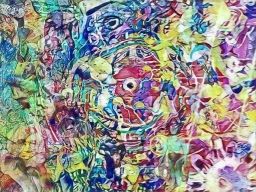






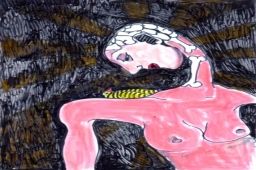
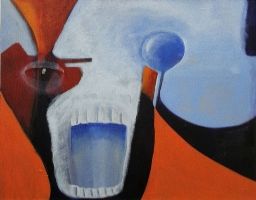
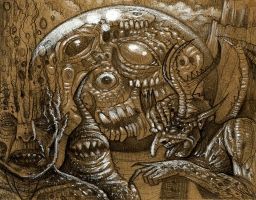



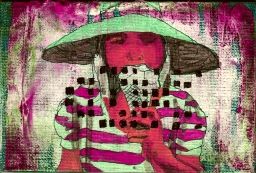


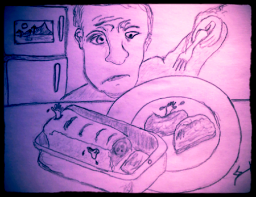
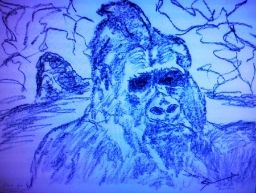
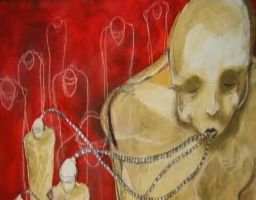
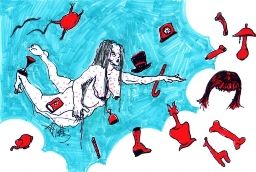

No comments:
Post a Comment